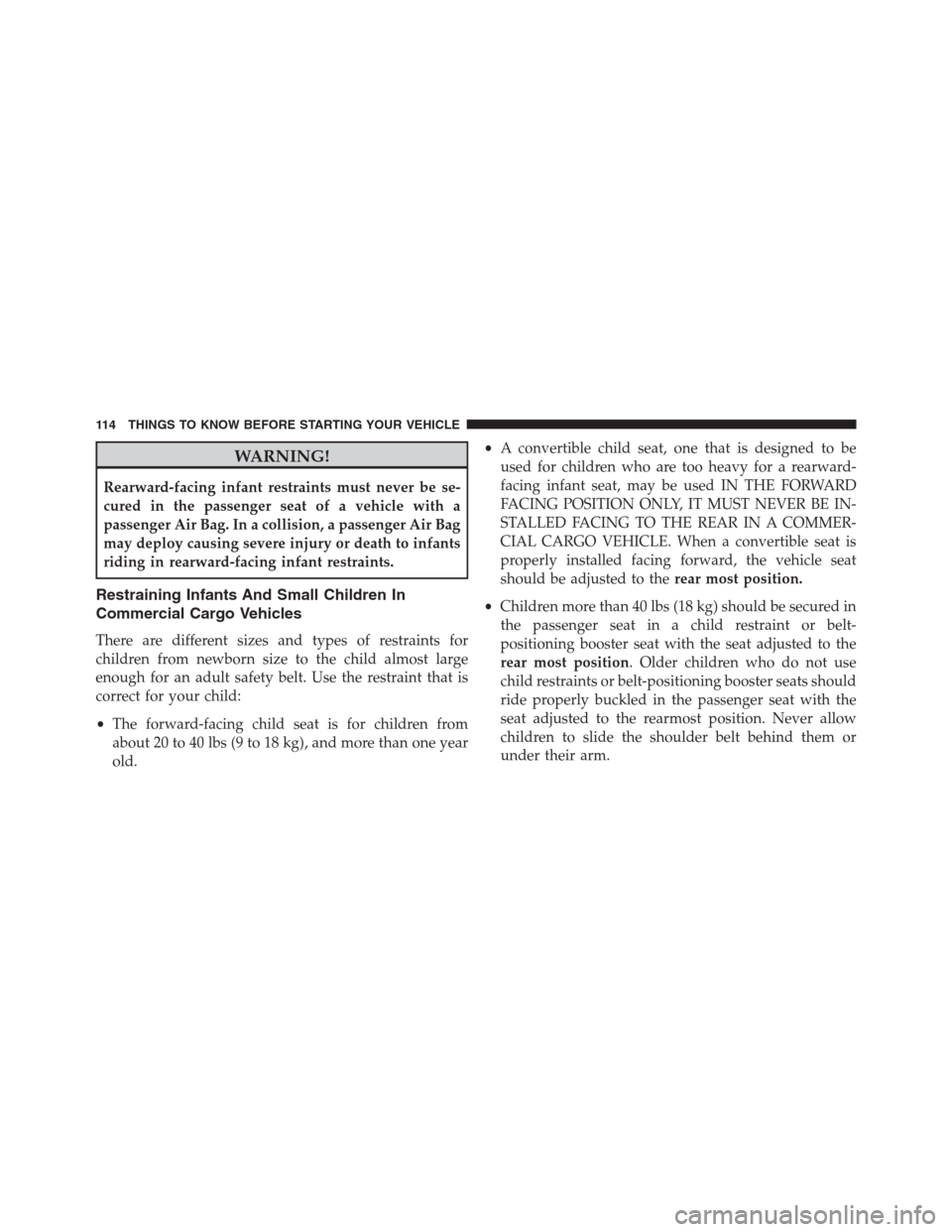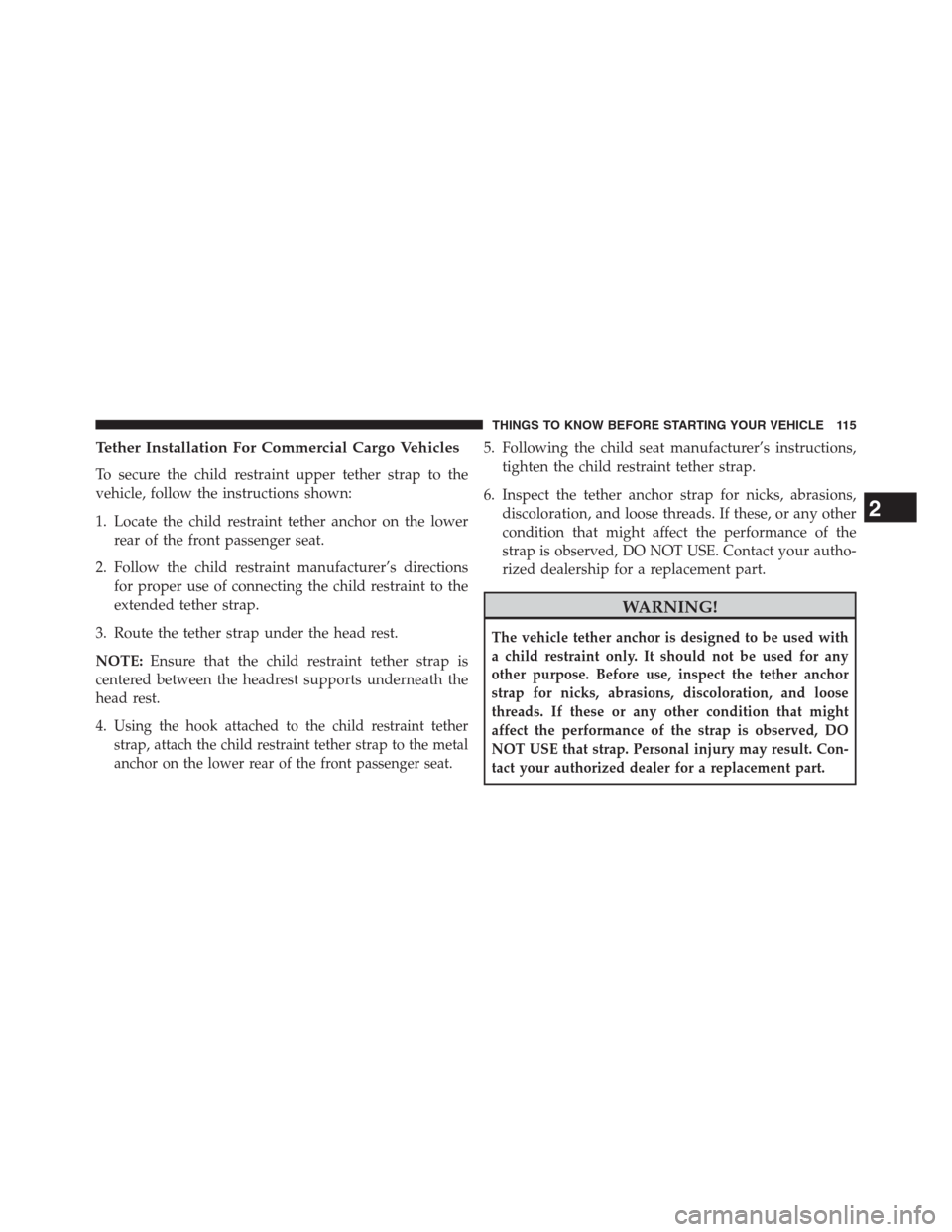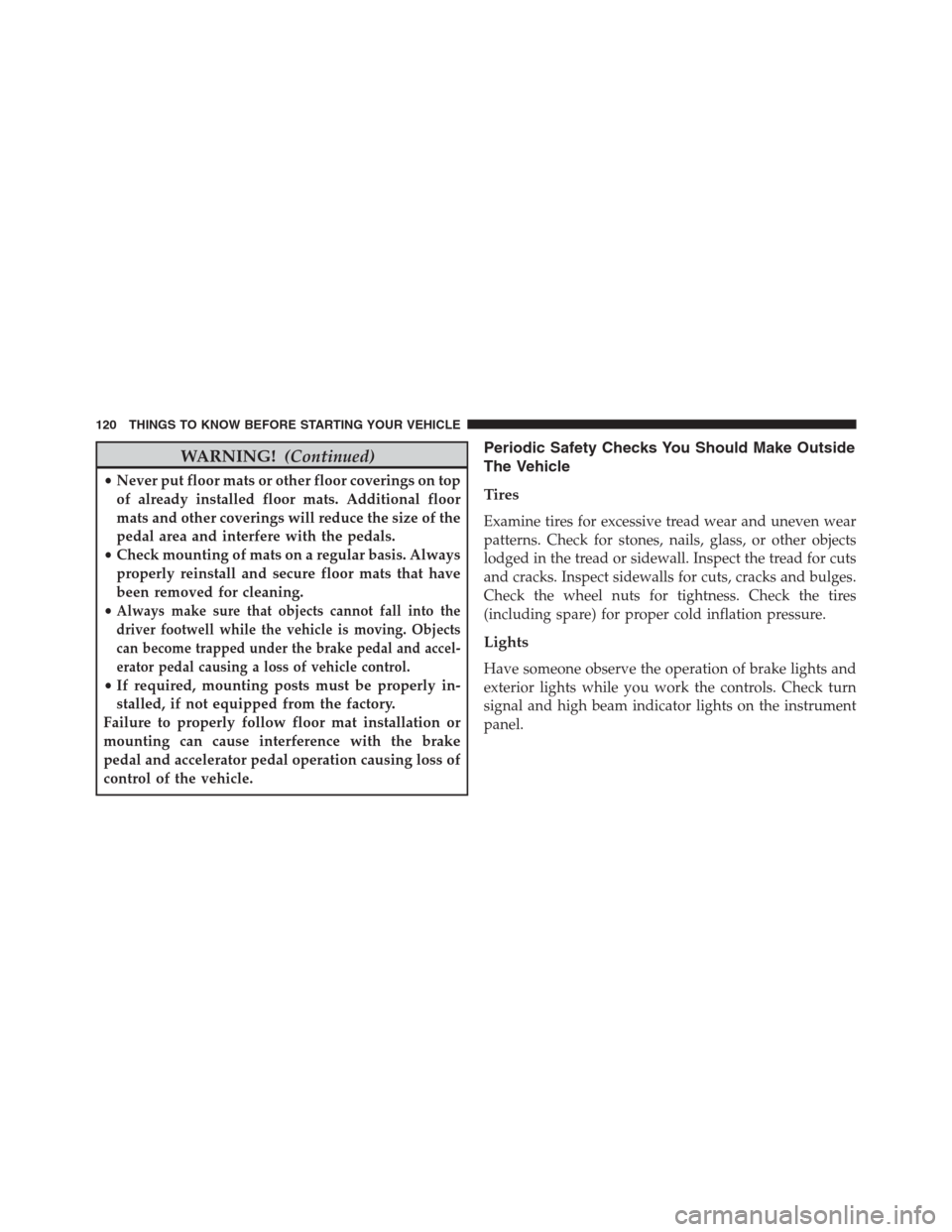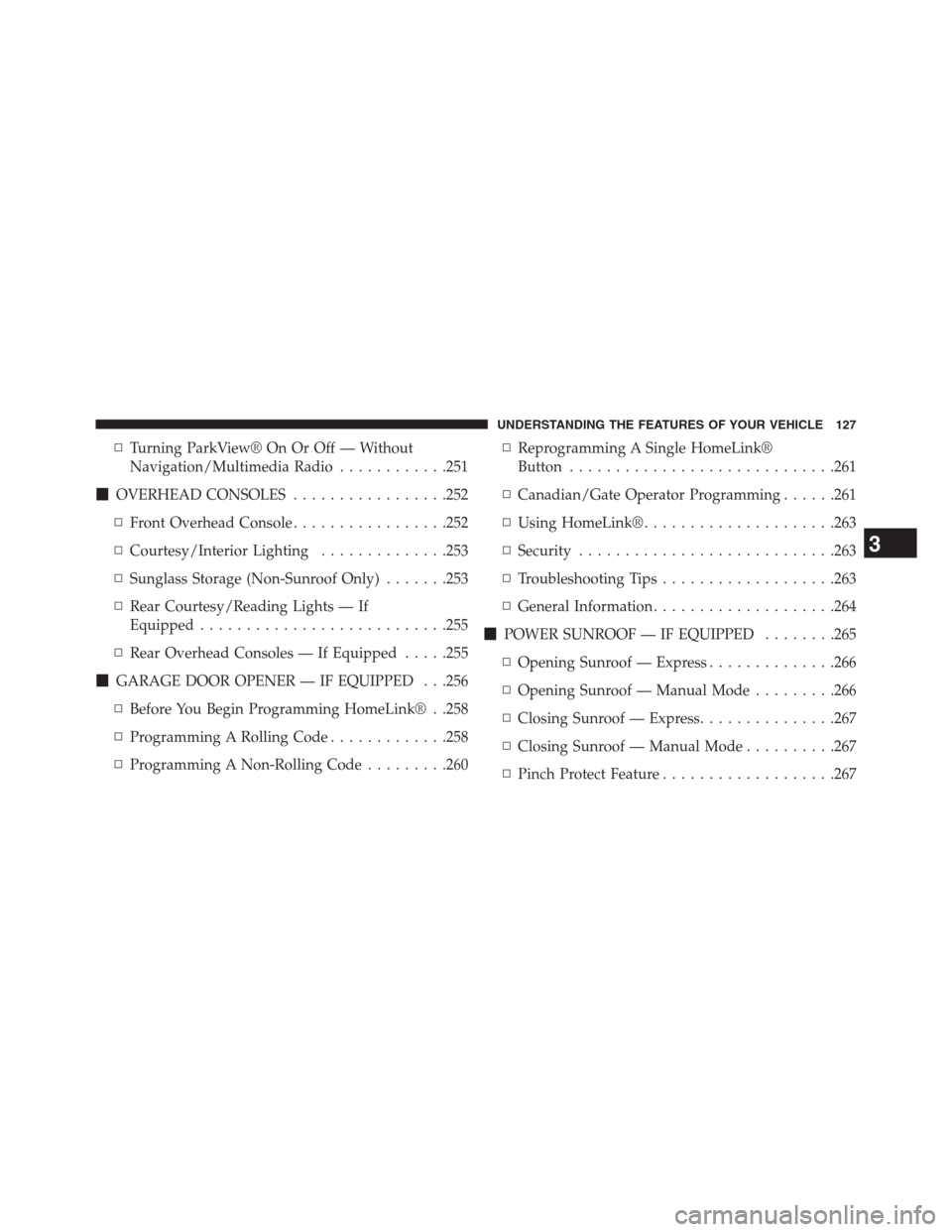Page 115 of 683
COMMERCIAL CARGO VEHICLES (NO FACTORY
INSTALLED REAR SEATS) — IF EQUIPPED
Commercial cargo vehicles are not designed for use as a
family vehicle and are not intended for carrying children
in the front passenger seat. However, if you must carry a
child in a vehicle without a rear seat, the passenger seat
should be moved to the full rearward position and the
child must be in a proper restraint system based on its
age, size and weight.
WARNING!
NEVER carry a child in a rear facing infant carrier in
a vehicle without rear seats. In a collision, serious
injury or death may occur from the deploying pas-
senger Air Bag.This vehicle is equipped with a child restraint tether
anchor located on the lower rear of the front passenger
seat.Use this tether anchor to secure only forward-
facing child restraints equipped with an upper tether
strap.Commercial Child Restraint Tether Anchor
2
THINGS TO KNOW BEFORE STARTING YOUR VEHICLE 113
Page 116 of 683

WARNING!
Rearward-facing infant restraints must never be se-
cured in the passenger seat of a vehicle with a
passenger Air Bag. In a collision, a passenger Air Bag
may deploy causing severe injury or death to infants
riding in rearward-facing infant restraints.
Restraining Infants And Small Children In
Commercial Cargo Vehicles
There are different sizes and types of restraints for
children from newborn size to the child almost large
enough for an adult safety belt. Use the restraint that is
correct for your child:
•The forward-facing child seat is for children from
about 20 to 40 lbs (9 to 18 kg), and more than one year
old.•A convertible child seat, one that is designed to be
used for children who are too heavy for a rearward-
facing infant seat, may be used IN THE FORWARD
FACING POSITION ONLY, IT MUST NEVER BE IN-
STALLED FACING TO THE REAR IN A COMMER-
CIAL CARGO VEHICLE. When a convertible seat is
properly installed facing forward, the vehicle seat
should be adjusted to therear most position.
•Children more than 40 lbs (18 kg) should be secured in
the passenger seat in a child restraint or belt-
positioning booster seat with the seat adjusted to the
rear most position. Older children who do not use
child restraints or belt-positioning booster seats should
ride properly buckled in the passenger seat with the
seat adjusted to the rearmost position. Never allow
children to slide the shoulder belt behind them or
under their arm.
114 THINGS TO KNOW BEFORE STARTING YOUR VEHICLE
Page 117 of 683

Tether Installation For Commercial Cargo Vehicles
To secure the child restraint upper tether strap to the
vehicle, follow the instructions shown:
1. Locate the child restraint tether anchor on the lower
rear of the front passenger seat.
2. Follow the child restraint manufacturer’s directions
for proper use of connecting the child restraint to the
extended tether strap.
3. Route the tether strap under the head rest.
NOTE:Ensure that the child restraint tether strap is
centered between the headrest supports underneath the
head rest.
4.
Using the hook attached to the child restraint tether
strap, attach the child restraint tether strap to the metal
anchor on the lower rear of the front passenger seat.
5. Following the child seat manufacturer’s instructions,
tighten the child restraint tether strap.
6. Inspect the tether anchor strap for nicks, abrasions,
discoloration, and loose threads. If these, or any other
condition that might affect the performance of the
strap is observed, DO NOT USE. Contact your autho-
rized dealership for a replacement part.
WARNING!
The vehicle tether anchor is designed to be used with
a child restraint only. It should not be used for any
other purpose. Before use, inspect the tether anchor
strap for nicks, abrasions, discoloration, and loose
threads. If these or any other condition that might
affect the performance of the strap is observed, DO
NOT USE that strap. Personal injury may result. Con-
tact your authorized dealer for a replacement part.
2
THINGS TO KNOW BEFORE STARTING YOUR VEHICLE 115
Page 121 of 683

Air Bag Warning Light
The light should come on and remain on for four
to eight seconds as a bulb check when the
ignition switch is first turned ON. If the light is
not lit during starting, see your authorized
dealer. If the light stays on, flickers, or comes on while
driving, have the system checked by an authorized dealer.
Defroster
Check operation by selecting the defrost mode and place
the blower control on high speed. You should be able to feel
the air directed against the windshield. See your autho-
rized dealer for service if your defroster is inoperable.
Floor Mat Safety Information
Always use floor mats designed to fit the footwell of your
vehicle. Use only floor mats that leave the pedal area
unobstructed and that are firmly secured so that they
cannot slip out of position and interfere with the pedals
or impair safe operation of your vehicle in other ways.
WARNING!
Pedals that cannot move freely can cause loss of
vehicle control and increase the risk of serious per-
sonal injury.
•Always make sure that floor mats are properly
attached to the floor mat fasteners.
•
Never place or install floor mats or other floor cover-
ings in the vehicle that cannot be properly secured to
prevent them from moving and interfering with the
pedals or the ability to control the vehicle.
(Continued)
2
THINGS TO KNOW BEFORE STARTING YOUR VEHICLE 119
Page 122 of 683

WARNING!(Continued)
•Never put floor mats or other floor coverings on top
of already installed floor mats. Additional floor
mats and other coverings will reduce the size of the
pedal area and interfere with the pedals.
•Check mounting of mats on a regular basis. Always
properly reinstall and secure floor mats that have
been removed for cleaning.
•
Always make sure that objects cannot fall into the
driver footwell while the vehicle is moving. Objects
can become trapped under the brake pedal and accel-
erator pedal causing a loss of vehicle control.
•If required, mounting posts must be properly in-
stalled, if not equipped from the factory.
Failure to properly follow floor mat installation or
mounting can cause interference with the brake
pedal and accelerator pedal operation causing loss of
control of the vehicle.
Periodic Safety Checks You Should Make Outside
The Vehicle
Tires
Examine tires for excessive tread wear and uneven wear
patterns. Check for stones, nails, glass, or other objects
lodged in the tread or sidewall. Inspect the tread for cuts
and cracks. Inspect sidewalls for cuts, cracks and bulges.
Check the wheel nuts for tightness. Check the tires
(including spare) for proper cold inflation pressure.
Lights
Have someone observe the operation of brake lights and
exterior lights while you work the controls. Check turn
signal and high beam indicator lights on the instrument
panel.
120 THINGS TO KNOW BEFORE STARTING YOUR VEHICLE
Page 129 of 683

▫Turning ParkView® On Or Off — Without
Navigation/Multimedia Radio............251
�OVERHEAD CONSOLES.................252
▫Front Overhead Console.................252
▫Courtesy/Interior Lighting..............253
▫Sunglass Storage (Non-Sunroof Only).......253
▫Rear Courtesy/Reading Lights — If
Equipped...........................255
▫Rear Overhead Consoles — If Equipped.....255
�GARAGE DOOR OPENER — IF EQUIPPED . . .256
▫Before You Begin Programming HomeLink® . .258
▫Programming A Rolling Code.............258
▫Programming A Non-Rolling Code.........260▫Reprogramming A Single HomeLink®
Button.............................261
▫Canadian/Gate Operator Programming......261
▫Using HomeLink®.....................263
▫Security............................263
▫Troubleshooting Tips...................263
▫General Information....................264
�POWER SUNROOF — IF EQUIPPED........265
▫Opening Sunroof — Express..............266
▫Opening Sunroof — Manual Mode.........266
▫Closing Sunroof — Express...............267
▫Closing Sunroof — Manual Mode..........267
▫Pinch Protect Feature...................267
3
UNDERSTANDING THE FEATURES OF YOUR VEHICLE 127
Page 197 of 683

NOTE:
•The head restraints should only be removed by quali-
fied technicians, for service purposes only. If either of
the head restraints require removal, see your autho-
rized dealer.
•In the event of deployment of an Active Head Re-
straint, refer to “Occupant Restraints/Resetting Active
Head Restraints (AHR)” in “Things To Know Before
Starting Your Vehicle” for further information.WARNING!
•Do not place items over the top of the Active Head
Restraint, such as coats, seat covers or portable DVD
players. These items may interfere with the opera-
tion of the Active Head Restraint in the event of a
collision and could result in serious injury or death.
•Active Head Restraints may be deployed if they are
struck by an object such as a hand, foot or loose
cargo. To avoid accidental deployment of the Ac-
tive Head Restraint ensure that all cargo is secured,
as loose cargo could contact the Active Head Re-
straint during sudden stops. Failure to follow this
warning could cause personal injury if the Active
Head Restraint is deployed.
3
UNDERSTANDING THE FEATURES OF YOUR VEHICLE 195
Page 223 of 683
Use the hood prop rod to secure the hood in the open
position.CAUTION!
To prevent possible damage, do not slam the hood to
close it. Lower the hood until it is open approxi-
mately 12 in (30 cm) and then drop it. This should
secure both latches. Never drive your vehicle unless
the hood is fully closed, with both latches engaged.
WARNING!
Be sure the hood is fully latched before driving your
vehicle. If the hood is not fully latched, it could open
when the vehicle is in motion and block your vision.
Failure to follow this warning could result in serious
injury or death.
Hood Prop Rod
3
UNDERSTANDING THE FEATURES OF YOUR VEHICLE 221